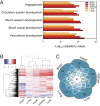The in vivo endothelial cell translatome is highly heterogeneous across vascular beds
- PMID: 31712416
- PMCID: PMC6876253
- DOI: 10.1073/pnas.1912409116
The in vivo endothelial cell translatome is highly heterogeneous across vascular beds
Abstract
Endothelial cells (ECs) are highly specialized across vascular beds. However, given their interspersed anatomic distribution, comprehensive characterization of the molecular basis for this heterogeneity in vivo has been limited. By applying endothelial-specific translating ribosome affinity purification (EC-TRAP) combined with high-throughput RNA sequencing analysis, we identified pan EC-enriched genes and tissue-specific EC transcripts, which include both established markers and genes previously unappreciated for their presence in ECs. In addition, EC-TRAP limits changes in gene expression after EC isolation and in vitro expansion, as well as rapid vascular bed-specific shifts in EC gene expression profiles as a result of the enzymatic tissue dissociation required to generate single-cell suspensions for fluorescence-activated cell sorting or single-cell RNA sequencing analysis. Comparison of our EC-TRAP with published single-cell RNA sequencing data further demonstrates considerably greater sensitivity of EC-TRAP for the detection of low abundant transcripts. Application of EC-TRAP to examine the in vivo host response to lipopolysaccharide (LPS) revealed the induction of gene expression programs associated with a native defense response, with marked differences across vascular beds. Furthermore, comparative analysis of whole-tissue and TRAP-selected mRNAs identified LPS-induced differences that would not have been detected by whole-tissue analysis alone. Together, these data provide a resource for the analysis of EC-specific gene expression programs across heterogeneous vascular beds under both physiologic and pathologic conditions.
Keywords: RNA sequencing; endothelial cell; gene expression.
Conflict of interest statement
The authors declare no competing interest.
Figures







References
-
- Aird W. C., Phenotypic heterogeneity of the endothelium: II. Representative vascular beds. Circ. Res. 100, 174–190 (2007). - PubMed
-
- Potente M., Mäkinen T., Vascular heterogeneity and specialization in development and disease. Nat. Rev. Mol. Cell Biol. 18, 477–494 (2017). - PubMed
-
- Ribatti D., Nico B., Vacca A., Roncali L., Dammacco F., Endothelial cell heterogeneity and organ specificity. J. Hematother. Stem Cell Res. 11, 81–90 (2002). - PubMed
Publication types
MeSH terms
Substances
Grants and funding
LinkOut - more resources
Full Text Sources
Other Literature Sources
Molecular Biology Databases

